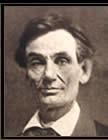by Grant B. Romer, Conservator, George Eastman House, Rochester, NY
On February 12, 1980, I examined, conserved, and documented the sixth-plate cased daguerreotype portrait believed by Mr. Albert Kaplan to be of Abraham Lincoln, which he purchased in 1977 from an art gallery in New York. Such retailers usually acquire groups of daguerreotypes for resale from wholesalers in photographia who in turn have gathered quantities of stock from a variety of other dealers, none of whom normally record the transaction details. The field is notoriously lax in recording or transmitting information as to provenance of daguerreotypes of all levels of value and importance. Typically, daguerreotype collections are assembled from many different regional sources, frequently separated from related, informative materials. Efforts to trace the original source of this daguerreotype are unlikely to be successful.
In the interest of gaining more information, either positive or negative, in determining the identity of the subject, its date of production, its maker, etc., and creating proper documentation of any intervention, Mr. Kaplan requested that someone properly qualified at the International Museum of Photography at George Eastman House make that examination and documentation. The task was given to me as both Conservator and historian of American daguerrean production. My findings and actions on that day were as follows:
Examination Report
The image is housed in a dark brown "Turkey" leather covered wooden case. The front cover bears a shallow embossed abstracted floral design. The rear cover is without decoration, with four beveled sides. There is fingernail abrasion damage to the leather, exposing the wooden interior structure to the right of the closure hook. The interior of the front cover has a purple silk-covered cushion which has faded and spotted in the areas which have been in contact with the cover glass, gilded octagonal opening mat, and image bearing plate. There is no "Preserver" binding frame. The case is in remarkably good condition, obviously carefully stored and handled throughout its history. The entire case and framing package is typical of American daguerreotype productions of the 1840's. There is no evident reason to doubt that the total package configuration is anything other than original.
 |
|
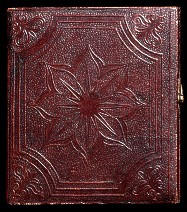 |
 |
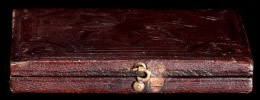 Case size: 3 1/8 x 3 5/8 inches |
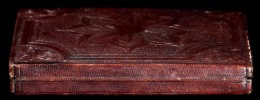 Plate package in case as presented |
The cover glass is clean on the exterior and interior surfaces, with no sign of dirt or decomposition. The brass mat has abraded the plate in several places at the edges of the mat opening. The plate is vignetted by a purple tarnish shading to dark blue. The mat abrasions at the top horizontal border above the sitter's head and at the top right, bottom right, and bottom left angles of the mat opening are scratched through this tarnish revealing bright silver. This fact and the clean glass surface indicates the possibility that the plate package has been opened at some recent time, probably by the gallery, to prepare the daguerreotype for display and sale by cleaning the glass of decomposition residue.
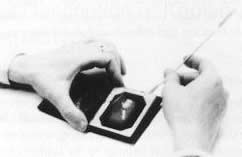 Plate package after removal from case showing masking tape seal |
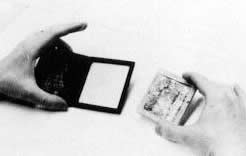 Examination of varnish-like material on rear of plate |
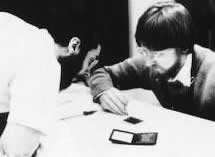 Interior examination |
The plate package (cover glass, mat and plate) was carefully lifted out with a suction cup. There was little resistance, again indicating prior removal. This was immediately confirmed by the appearance of modern masking tape used to bind the package together. Evidently the original seal had been broken and removed in order to clean the cover glass. The rear of the plate retained some brown, brittle adhesive residue from the original seal. The masking tape was removed and the plate freed from the package.
This is a silver clad, copper backed plate of American manufacture, proven by the plate maker's inscription which appears at the top border of the front of the plate. This inscription, stamped into the silver, reads "E. WHITE MAKER N.Y. SECOND QUALITY". Edward White was a daguerreotypist and plate manufacturer in New York City. His exact dates of activity are not known; however he is listed in the New York City business directory in 1843, '44 and '50. In all probability he was active throughout the 1840s. In letters in the IMP/GEH collection from White to Southworth & Hawes there is reference to his commenced manufacturing activities. On December 14, 1844, White wrote "... we have commenced manufacturing plates". Daguerreotype plates were graded according to the purity and thickness of silver, hence the "Second Quality" inscription. Although it is reasonable to assume that White used his own brand of plates in his studio, attribution of authorship cannot be made on the basis of this inscription alone.
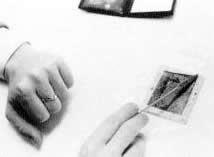 First lifting of masking tape seal |
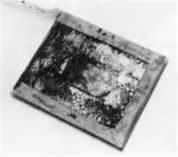 Rear of plate packaging, masking tape being removed |
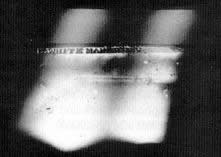 Plate maker's mark at top left edge of plate - "E. WHITE MAKER NY" |
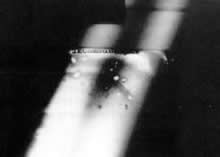 Plate maker's mark at top right edge of plate - "SECOND QUALITY" |
- The plate has clipped corners to keep the plate from catching on the polishing buff, otherwise it is undistorted. The polishing marks are horizontal to the image axis as was standard practice.
- The tarnish formation clearly indicates that the overmat is original to the plate. Indeed, except for the seal, I see no reason to doubt that the entire package is original.
- The plate was photographed in black and white, and color transparencies, and immediately archivally re-sealed.
- The image of the daguerreotype is laterally inverted as is typical with most daguerreotypes. In order to view the image as one would have viewed the subject in life it is necessary to reverse the negative during the process of making a modern print. Both Meserve #1 and the Kaplan daguerreotype should be reversed to permit the viewer to correlate these images with the later life images of Lincoln.
Conclusion
From interior and exterior evidence, I conclude that this daguerreotype is an entirely American product made prior to 1845. The style of case, plate housing, sitter's dress, and hair style suggest an earlier rather than later 1840's date. The style of the pose and lighting in combination with the fine attire of the sitter suggest an urban rather than rural setting. The technical quality of the daguerreotype is very fine and above average for the period. No physical evidence in the form of an inscription, label, or stamp, beyond those above noted, is present.
